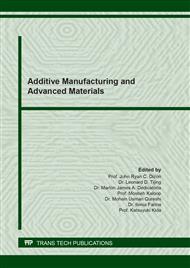[1]
ACI 237R, Self-Consolidating Concrete, in: American Concrete Institute, (2019).
Google Scholar
[2]
EFNARC, The European Guidelines for Self-Compacting Concrete: Specification, Production and Use, (2005).
Google Scholar
[3]
S. Iqbal, A. Ali, K. Holschemacher, Y. Ribakov, T.A. Bier, Effect of fly ash on properties of self-compacting high strength lightweight concrete, Periodica Polytechnica Civil Engineering. 61 (2017) 81–87. https://doi.org/10.3311/PPci.8171.
DOI: 10.3311/ppci.8171
Google Scholar
[4]
S. Türkel, Y. Altuntaş, The effect of limestone powder, fly ash and silica fume on the properties of self-compacting repair mortars, Sadhana. 34 (2009) 331–343. https://doi.org/10.1007/ s12046-009-0011-3.
DOI: 10.1007/s12046-009-0011-3
Google Scholar
[5]
H. Sasanipour, F. Aslani, J. Taherinezhad, Effect of silica fume on durability of self-compacting concrete made with waste recycled concrete aggregates, Construction and Building Materials. 227 (2019) 116598. https://doi.org/https://doi.org/10.1016/j.conbuildmat.2019.07.324.
DOI: 10.1016/j.conbuildmat.2019.07.324
Google Scholar
[6]
S. Lenka, K. Panda, Effect of metakaolin on the properties of conventional and self compacting concrete, Advances in Concrete Construction. 5 (2017) 31–48. https://doi.org/10.12989/ acc.2017.5.1.31.
DOI: 10.12989/acc.2017.5.1.31
Google Scholar
[7]
J.D. Ríos, A. Vahí, C. Leiva, A.M. Martínez-De la Concha, H. Cifuentes, Analysis of the utilization of air-cooled blast furnace slag as industrial waste aggregates in self-compacting concrete, Sustainability (Switzerland). 11 (2019). https://doi.org/10.3390/su11061702.
DOI: 10.3390/su11061702
Google Scholar
[8]
N. Al-Kindi, A. Al-Moqbali, M. Qureshi, A. Al-Shidi, I. Ala-Aldhen, Mechanical characteristics of recycled concrete aggregates as backfill material, International Journal of Applied Engineering Research. 11 (2016).
Google Scholar
[9]
ASTM C125, Standard Terminology Relating to Concrete and Concrete Aggregates, (2020).
Google Scholar
[10]
ASTM C618, Standard Specification for Coal Fly Ash and Raw or Calcined Natural Pozzolan for Use, Annual Book of ASTM Standards. (2019).
DOI: 10.1520/c0618-00
Google Scholar
[11]
M. Singh, R. Siddique, Effect of coal bottom ash as partial replacement of sand on properties of concrete, Resources, Conservation and Recycling. 72 (2013) 20–32. https://doi.org/https://doi.org/10.1016/j.resconrec.2012.12.006.
DOI: 10.1016/j.resconrec.2012.12.006
Google Scholar
[12]
M. Lachemi, K.M.A. Hossain, V. Lambros, P.C. Nkinamubanzi, N. Bouzoubaâ, Self-consolidating concrete incorporating new viscosity modifying admixtures, Cement and Concrete Research. 34 (2004) 917–926. https://doi.org/10.1016/J.CEMCONRES.2003.10.024.
DOI: 10.1016/j.cemconres.2003.10.024
Google Scholar
[13]
J.M. Khatib, Performance of self-compacting concrete containing fly ash, Construction and Building Materials. 22 (2008) 1963–1971. https://doi.org/10.1016/J.CONBUILDMAT. 2007.07.011.
DOI: 10.1016/j.conbuildmat.2007.07.011
Google Scholar
[14]
W. Wongkeo, P. Thongsanitgarn, A. Ngamjarurojana, A. Chaipanich, Compressive strength and chloride resistance of self-compacting concrete containing high level fly ash and silica fume, Materials & Design. 64 (2014) 261–269. https://doi.org/10.1016/J.MATDES. 2014.07.042.
DOI: 10.1016/j.matdes.2014.07.042
Google Scholar
[15]
H. Yazici, The effect of silica fume and high-volume Class C fly ash on mechanical properties, chloride penetration and freeze–thaw resistance of self-compacting concrete, Construction and Building Materials. 22 (2008) 456–462. https://doi.org/10.1016/J.CONBUILDMAT. 2007.01.002.
DOI: 10.1016/j.conbuildmat.2007.01.002
Google Scholar
[16]
K. Turk, M. Karatas, Abrasion resistance and mechanical properties of self-compacting concrete with different dosages of fly ash/silica fume, Indian Journal of Engineering and Materials Sciences. 18 (2011) 49–60.
Google Scholar
[17]
K. Turk, M. Karatas, T. Gonen, Effect of Fly Ash and Silica Fume on compressive strength, sorptivity and carbonation of SCC, KSCE Journal of Civil Engineering. 17 (2013) 202–209. https://doi.org/10.1007/s12205-013-1680-3.
DOI: 10.1007/s12205-013-1680-3
Google Scholar
[18]
ASTM C33, Standard Specification for Concrete Aggregates, ASTM International, West Conshohocken. (2018).
Google Scholar
[19]
ASTM C150, Standard specification for portland cement, ASTM International, West Conshohocken, PA. (2020).
Google Scholar
[20]
H. Okamura, K. Ozawa, M. Ouchi, Self-compacting concrete, Structural Concrete. 2 (2000) 3–17.
DOI: 10.1680/stco.2000.1.1.3
Google Scholar
[21]
EFNARC, Specification and Guidelines for Self-Compacting Concrete, Report from EFNARC. (2002).
Google Scholar
[22]
ASTM C39, Standard Test Method for Compressive Strength of Cylindrical Concrete Specimens: C39/C39M-18, American Society for Testing and Materials. (2018).
Google Scholar
[23]
ASTM C293, Standard Test Method for Flexural Strength of Concrete (Using Simple Beam With Center-Point Loading), (2016).
DOI: 10.1520/c0293_c0293m-10
Google Scholar
[24]
ASTM C1585, Standard Test Method for Measurement of Rate of Absorption of Water by Hydraulic-Cement Concretes, (2020).
Google Scholar
[25]
ASTM C642, Standard Test Method for Density, Absorption, and Voids in Hardened Concrete, (2013).
Google Scholar


